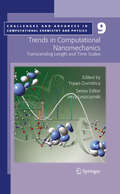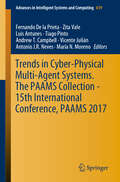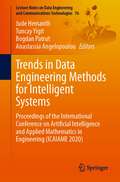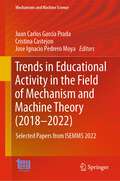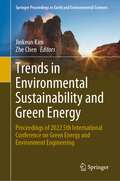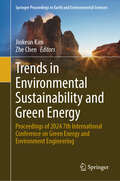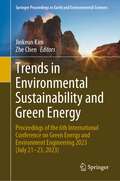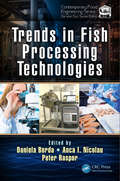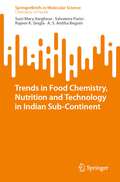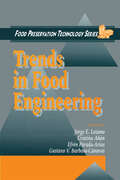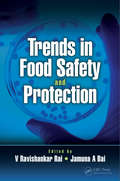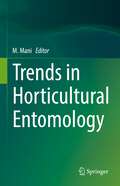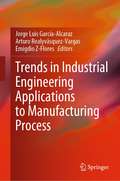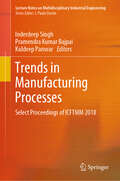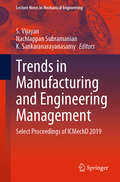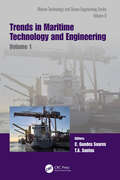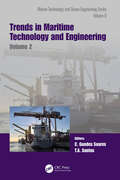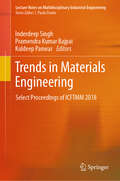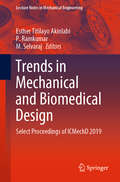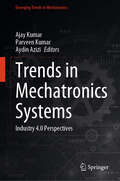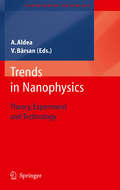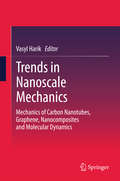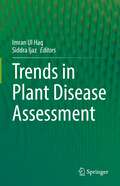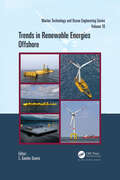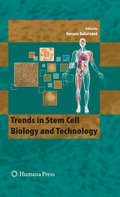- Table View
- List View
Trends in Computational Nanomechanics
by Traian DumitricaTrends in Computational Nanomechanics reviews recent advances in analytical and computational modeling frameworks to describe the mechanics of materials on scales ranging from the atomistic, through the microstructure or transitional, and up to the continuum. The book presents new approaches in the theory of nanosystems, recent developments in theoretical and computational methods for studying problems in which multiple length and/or time scales must be simultaneously resolved, as well as example applications in nanomechanics. This title will be a useful tool of reference for professionals, graduates and undergraduates interested in Computational Chemistry and Physics, Materials Science, Nanotechnology.
Trends in Cyber-Physical Multi-Agent Systems. The PAAMS Collection - 15th International Conference, PAAMS 2017 (Advances in Intelligent Systems and Computing #619)
by Vicente Julián Fernando De la Prieta Zita Vale Tiago Pinto Luis Antunes Andrew T. Campbell María N. Moreno Antonio J. R. NevesPAAMS, the International Conference on Practical Applications of Agents and Multi-Agent Systems is an evolution of the International Workshop on Practical Applications of Agents and Multi-Agent Systems. PAAMS is an international yearly tribune to present, to discuss, and to disseminate the latest developments and the most important outcomes related to real-world applications. It provides a unique opportunity to bring multi-disciplinary experts, academics and practitioners together to exchange their experience in the development of Agents and Multi-Agent Systems. This volume presents the papers that have been accepted for the 2017 in the special sessions: Agent-Based Social Simulation, Modelling and Big-Data Analytics (ABM); Advances on Demand Response and Renewable Energy Sources in Agent Based Smart Grids (ADRESS); Agents and Mobile Devices (AM); Computer vision in Multi-Agent Robotics (RV); Persuasive Technologies (PT); Web and Social Media Mining (WASMM). The volume also includes the papers accepted for publication in the Doctoral Consortium (DCAI, DCAI-DECON, ISAMI, MIS4TEL, PAAMS, PACBB 2017 conferences).
Trends in Data Engineering Methods for Intelligent Systems
by Jude Hemanth Bogdan Patrut Tuncay Yigit Anastassia AngelopoulouThis book briefly covers internationally contributed chapters with artificial intelligence and applied mathematics-oriented background-details. Nowadays, the world is under attack of intelligent systems covering all fields to make them practical and meaningful for humans. In this sense, this edited book provides the most recent research on use of engineering capabilities for developing intelligent systems. The chapters are a collection from the works presented at the 2nd International Conference on Artificial Intelligence and Applied Mathematics in Engineering held within 09-10-11 October 2020 at the Antalya, Manavgat (Turkey). The target audience of the book covers scientists, experts, M.Sc. and Ph.D. students, post-docs, and anyone interested in intelligent systems and their usage in different problem domains. The book is suitable to be used as a reference work in the courses associated with artificial intelligence and applied mathematics.
Trends in Educational Activity in the Field of Mechanism and Machine Theory: Selected Papers from ISEMMS 2022 (Mechanisms and Machine Science #128)
by Juan Carlos García Prada Cristina Castejon Jose Ignacio Pedrero MoyaThis book presents content from the Third International Symposium on the Education in Mechanism and Machine Science (ISEMMS 2022). Among others, the chapters report on mechanical engineering education, mechanism and machine science in the mechanical engineer curricula, methodology, virtual laboratories and new laws. Special attention is given to MMS experiences in Pandemic times. The chapters discuss the current problems in MMS education with the aim of providing solutions and identifying appropriate trends for a modern world common vision in the Engineering education field.
Trends in Environmental Sustainability and Green Energy: Proceedings of 2022 5th International Conference on Green Energy and Environment Engineering (Springer Proceedings in Earth and Environmental Sciences)
by Zhe Chen Jinkeun KimThis book consists of selected and peer-reviewed papers of 2022 5th International Conference on Green Energy and Environment Engineering (CGEEE 2022), held in Jeju Island, Korea during July 28-30, 2022. CGEEE 2022 provides a forum for researchers and practitioners in the field of green energy and environment engineering to share ideas, designs, and experiments results. Various topics are covered in this book, such as carbon capture and storage, solar energy, biomass, biofuel, geothermal, sustainable cities, energy savings for vehicular technology, solid waste management, waste minimization, water treatment and reclamation, environmental restoration, and ecological engineering. This book will be beneficial to researchers, educators, practitioners, and policymakers working in the related fields.
Trends in Environmental Sustainability and Green Energy: Proceedings of 2024 7th International Conference on Green Energy and Environment Engineering (Springer Proceedings in Earth and Environmental Sciences)
by Zhe Chen Jinkeun KimThis book comprises of selected and peer-reviewed papers presented at the 2024 7th International Conference on Green Energy and Environment Engineering (CGEEE 2024), in Seoul, South Korea during July 4-6, 2024. The conference is sponsored by University of Seoul, Korea, co-sponsored by Jeju National University, and Jeju Green Environment Centre, which aims to bring together innovative academics and industrial experts from all over the world. Topics discussed at the conference include environmental pollution and control, wastewater treatment, climate change and ecosystems management, environmental restoration, environmental regulation and monitoring, environmental systems approach, energy efficiency, energy management. These chapters provide scientists and researchers with the latest advancements in the field of green energy and environment engineering. The book will prove a useful reference to researchers, practitioners, and policy makers.
Trends in Environmental Sustainability and Green Energy: Proceedings of the 6th International Conference on Green Energy and Environment Engineering 2023 (July 21-23, 2023) (Springer Proceedings in Earth and Environmental Sciences)
by Zhe Chen Jinkeun KimThis book offers a collection of papers presented at the 2023 6th International Conference on Green Energy and Environment Engineering (CGEEE 2023), held during July 21-23, 2023 in Jeju Island, Korea. Recent studies, promising ideas and new challenges are discussed among environmental engineers, economists and social scientists, demonstrating new paradigms for problem solving and decision making. The book provides researchers and practitioners in the field of in green energy and environmental science with the latest, cutting-edge thought and research in the field. It will appeal to readers interested in these fields, especially those who are looking for new ideas and research directions.
Trends in Fish Processing Technologies (Contemporary Food Engineering)
by Peter Raspor Daniela Borda Anca I. NicolauThe high market demand based on consumers’ trust in fish as a healthy and nutritious food resource made fish processing a very dynamic industry, spurring many innovations in processing and packaging methods. Trends in Fish Processing Technologies not only reflects what is currently new in fish processing but also points out where things are heading in this area. This book provides an overview of the modern technologies employed by the industry. It details the advances in fish processing, including high pressure processing (HPP), pulsed electric field (PEF) treatment and minimally heat processing combined with microwave (MW) and radio-frequency (RF). It provides references to food safety management systems and food safety & quality indicators for processed fish in order to achieve an adequate level of protection. Quality aspects and molecular methods for the assessment of fish and fish products integrity are introduced. Fish products reformulation trends based on sustainability principles that tackles the reduction of salt content and the use of natural antimicrobials are presented. Innovative packaging solutions for fish products are explored, detailing intelligent packaging with freshness and time-temperature indicators, applications of modified packaging atmosphere, antimicrobial bio-nanocomposite packaging materials and biodegradable edible films used as primary fish packaging. In addition to covering the current advancements in fish processing the book discusses fraud, adulteration, fair trade practices, traceability and the need for added value, clean and sustainable processing in the fish chain.
Trends in Food Chemistry, Nutrition and Technology in Indian Sub-Continent (SpringerBriefs in Molecular Science)
by Salvatore Parisi Rajeev K. Singla Suni Mary Varghese A. S. BegumThis brief outlines the state-of-art of the food industry within the Indian Sub-continent, providing a detailed insight into the current science of nutrition and industrial technology.The Hygiene, Integrity, Traceability and Sharing (HITS) strategy has been proposed recently as a coordinated and powerful tool to contextualize the plethora of different menaces for the food consumer. The book examines this approach from eight different perspectives, with a particular emphasis on the Indian Subcontinent. Topics such as food additives, the importance of water in the food industry, the use of antioxidants, and novel food preservation methods are used to illustrate these points of view.This book is particularly appealing as a guide for graduate and undergraduate courses covering food production, food safety, and the training of teachers working in these science areas.
Trends in Food Engineering
by Gustavo V. Barbosa-Cánovas Efrén Parada-Arias Jorge E. Lozano Cristina AñónTrends in Food Engineering presents a wide vision of food engineering, with an emphasis on topics vital to the food industry today. The first section deals with physical and sensory properties of food. The emphasis in these chapters is on structure-function relationships, food rheology, and the correlations between physicochemical and sensory data.
Trends in Food Safety and Protection
by V Ravishankar Rai Jamuna A BaiTrends in Food Safety and Protection explores the recent developments and ongoing research in the field of food safety and protection. The book covers improvements in the existing techniques and implementation of novel analytical methods for detecting and characterizing foodborne pathogens.
Trends in Horticultural Entomology
by M. ManiThis edited book highlights the latest information on the use of nanotechnology, satellite technology, and biotechnological tools in pest management. It covers the role of climate change and ecology in managing pests and also their molecular identification. Other methods that the book encompasses are organic pest management, host-plant resistance, semiochemicals, and bio-control technology. The book also covers insect pollinators which play important role for fruits in horticultural crop production. Intensive and extensive cultivation of horticultural crops lead to serious pest problem. Climatic conditions in India and elsewhere due to which new pests have emerged that causes severe damage to the horticultural crops. In response to this, researchers have developed new techniques to fight pests and their growing resistance to pesticides. This book covers the latest information on identity, biology, damage, seasonal development, and pest management of the horticultural crop pests. It serves to be an essential tool for horticultural professionals, including development officers, horticulturists, field-level extension workers, nurserymen, planters, and entomologists, and is a valuable source of reference for relevant researchers, teachers, and students in the region.
Trends in Industrial Engineering Applications to Manufacturing Process
by Jorge Luis García-Alcaraz Arturo Realyvásquez-Vargas Emigdio Z-FloresThis book covers supply chain and logistics, production and manufacturing systems as well as human factors. Topics such as applications to procurements from suppliers, suppliers developments and relationships with suppliers are reported. The techniques and tools applied to production processes, such as, machinery maintenance and quick changeover, are described in detail. The book also presents human factors as the main component in the industrial engineering field, reporting some successful teamwork organizations for improvements and applied ergonomics, among others.
Trends in Manufacturing Processes: Select Proceedings of ICFTMM 2018 (Lecture Notes on Multidisciplinary Industrial Engineering)
by Inderdeep Singh Pramendra Kumar Bajpai Kuldeep PanwarThis book comprises select proceedings of the International Conference on Futuristic Trends in Materials and Manufacturing (ICFTMM 2018). The volume covers current research findings in conventional and non-conventional manufacturing processes. Different fabrication processes of polymer based materials and advanced materials are discussed in this book. In addition, the book also discusses computer based manufacturing processes, and sustainable and green manufacturing technologies. The contents of this book will be useful for students, academicians, and researchers working in the field of manufacturing related fields.
Trends in Manufacturing and Engineering Management: Select Proceedings of ICMechD 2019 (Lecture Notes in Mechanical Engineering)
by Nachiappan Subramanian S. Vijayan K. SankaranarayanasamyThis book comprises select papers presented at the International Conference on Mechanical Engineering Design (ICMechD) 2019. The volume focuses on the different design aspects involved in manufacturing, composite materials processing as well as in engineering management. A wide range of topics such as control and automation, mechatronics, robotics, composite and nanomaterial design, and welding design are covered here. The book also discusses current research in engineering management on topics like products, services and system design, optimization in design, manufacturing planning and control, and sustainable product design. Given the range of the contents, this book will prove useful to students, researchers and practitioners.
Trends in Maritime Technology and Engineering: Proceedings of the 6th International Conference on Maritime Technology and Engineering (MARTECH 2022, Lisbon, Portugal, 24-26 May 2022) (Proceedings in Marine Technology and Ocean Engineering)
by C. Guedes SoaresTrends in Maritime Technology and Engineering comprises the papers presented at the 6th International Conference on Maritime Technology and Engineering (MARTECH 2022) that was held in Lisbon, Portugal, from 24-26 May 2022. The Conference has evolved from the series of biennial national conferences in Portugal, which have become an international event, and which reflect the internationalization of the maritime sector and its activities. MARTECH 2022 is the sixth of this new series of biennial conferences. The book covers all aspects of maritime activity, including in Volume 1: Structures, Hydrodynamics, Machinery, Control and Design. In Volume 2: Maritime Transportation and Ports, Maritime Traffic, Safety, Environmental Conditions, Renewable Energy, Oil & Gas, and Fisheries and Aquaculture. Trends in Maritime Technology and Engineering aims at academics and professionals in the above mentioned fields.
Trends in Maritime Technology and Engineering: Proceedings of the 6th International Conference on Maritime Technology and Engineering (MARTECH 2022, Lisbon, Portugal, 24-26 May 2022) (Proceedings in Marine Technology and Ocean Engineering)
by C. Guedes SoaresTrends in Maritime Technology and Engineering comprises the papers presented at the 6th International Conference on Maritime Technology and Engineering (MARTECH 2022) that was held in Lisbon, Portugal, from 24-26 May 2022. The Conference has evolved from the series of biennial national conferences in Portugal, which have become an international event, and which reflect the internationalization of the maritime sector and its activities. MARTECH 2022 is the sixth of this new series of biennial conferences. The book covers all aspects of maritime activity, including in Volume 1: Structures, Hydrodynamics, Machinery, Control and Design. In Volume 2: Maritime Transportation and Ports, Maritime Traffic, Safety, Environmental Conditions, Renewable Energy, Oil & Gas, and Fisheries and Aquaculture. Trends in Maritime Technology and Engineering aims at academics and professionals in the above mentioned fields.
Trends in Materials Engineering: Select Proceedings of ICFTMM 2018 (Lecture Notes on Multidisciplinary Industrial Engineering)
by Inderdeep Singh Pramendra Kumar Bajpai Kuldeep PanwarThis book comprises select proceedings of the International Conference on Futuristic Trends in Materials and Manufacturing (ICFTMM 2018). The book includes latest research on conventional materials, advanced metals and alloys, polymeric materials and composites. In addition to the characterization of different advanced materials, the book also discusses their applications in various fields such as marine, automotive, aerospace, sporting equipment, and infrastructure. The book offers an insight into the manufacturing of cost-effective and high performance materials products. The contents of this book will be useful for students, academicians, and researchers working in the field of materials science and engineering.
Trends in Mechanical and Biomedical Design: Select Proceedings of ICMechD 2019 (Lecture Notes in Mechanical Engineering)
by Esther Titilayo Akinlabi P. Ramkumar M. SelvarajThis book comprises select papers presented at the International Conference on Mechanical Engineering Design (ICMechD) 2019. The volume focuses on the recent trends in design research and their applications across the mechanical and biomedical domain. The book covers topics like tribology design, mechanism and machine design, wear and surface engineering, vibration and noise engineering, biomechanics and biomedical engineering, industrial thermodynamics, and thermal engineering. Case studies citing practical challenges and their solutions using appropriate techniques and modern engineering tools are also discussed. Given its contents, this book will prove useful to students, researchers as well as practitioners.
Trends in Mechatronics Systems: Industry 4.0 Perspectives (Emerging Trends in Mechatronics)
by Ajay Kumar Aydin Azizi Parveen KumarThis book consists of twelve chapters covering the design aspects, their feasibility, mathematical modeling by numerical, experimental, computational and simulation approaches. It discusses how different internet technologies integrate mechatronics systems with people, products and complex systems. The methodology and tools included in this book focus on contemporary aspects of integrating Industry 4.0 and mechatronics systems for new means and models to achieve a sustainable green environment. Readers will get an insight into the current development of mechatronics systems in the context of scientific disciplines and present new results of research and development, indicating the trends of development in this interdisciplinary field.
Trends in Nanophysics
by Alexandru Aldea Victor Bârsan"Trends in Nanophysics" contains reviews on various domains of nanotechnology such as: radiation-induced polymerization, cross-linking and grafting; Mossbauer study of nanomaterials; biomedical applications of nanomaterials; organic thin films for photovoltaics; growth and characterization of semiconductor nanowires; graphene and carbon nanotubes; fractional statistics in nanophysics; nanomechanical properties of materials; ab-initio simulations in nanoscience; fabrication and characterization of ordered atomic-scale structures; plasmonics; and nano-optical studies of motile structures of neuronal cells. These reviews cover key issues from experimental and theoretical nanophysics and are interesting for active researchers as well as for graduate and undergraduate students in the nanoscience field.
Trends in Nanoscale Mechanics
by Vasyl HarikThis book contains a collection of the state-of-the-art reviews written by the leading researchers in the areas of nanoscale mechanics, molecular dynamics, nanoscale modeling of nanocomposites and mechanics of carbon nanotubes. No other book provides reviews of recent discoveries such as a nanoscale analog of the Pauli's principle, i. e. , effect of the spatial exclusion of electrons or the SEE effect, a new Registry Matrix Analysis for the nanoscale interfacial sliding and new data on the effective viscosity of interfacial electrons in nanoscale stiction at the interfaces. This volume is also an exceptional resource on the well tested nanoscale modeling of carbon nanotubes and nanocomposites, new nanoscale effects, unique evaluations of the effective thickness of carbon nanotubes under different loads, new data on which size of carbon nanotubes is safer and many other topics. Extensive bibliography concerning all these topics is included along with the lucid short reviews. Numerous illustrations are provided for molecular dynamic simulations, fascinating nanoscale phenomena and remarkable new effects. It is of interest to a wide range of researchers and students.
Trends in Plant Disease Assessment
by Imran Ul Haq Siddra IjazThis edited book provides the readers with the concepts and in-depth knowledge of plant disease assessment and conventional and modern technologies that aid in precise and accurate phytomathometery. This book discusses the evolution of plant disease assessment procedures from the primary visual estimation-based assessment to modern approaches, their practical application for reliable disease quantification, yield loss estimation, and the efficacy of disease control strategies for sustainable crop protection. Significant information is provided on the major aspects of the topic, including remote sensing, imaging techniques, molecular phytopathometery, microarray, and immunotechnology. The book helps plant scientists, plant pathologists, practitioners, researchers, and students in disease quantification, developing predictive models for plant disease epidemics, assessing crop losses, and the magnitude of plant disease control methods. This book describes the classical plant disease assessment methods based on visual observations. It Provides information regarding the modern and emerging technologies in Phytopathometery, precision, and accuracy. This book also discusses the application of disease assessments in predictive models, disease warning systems, expert systems, and decision support systems in applied plant pathology.
Trends in Renewable Energies Offshore: Proceedings of the 5th International Conference on Renewable Energies Offshore (RENEW 2022, Lisbon, Portugal, 8–10 November 2022) (Proceedings in Marine Technology and Ocean Engineering)
by C. Guedes SoaresRenewable energy resources offshore are a growing contributor to the total energy production in a growing number of countries. As a result the interest in the topic is increasing. Trends in Renewable Energies Offshore includes the papers presented at the 5th International Conference on Renewable Energies Offshore (RENEW 2022, Lisbon, Portugal, 8-10 November 2022), and covers recent developments and experiences gained in concept development, design and operation of such devices. The scope of the contributions is broad, covering all aspects of renewable energies offshore activities, including: • Resource assessment • Tidal Energy • Wave Energy • Wind Energy • Solar Energy • Renewable Energy Devices • Multiuse Platforms • Maintenance planning • Materials and structural design Trends in Renewable Energies Offshore will be of interest to academics and professionals involved or interested in applications of renewable energy resources offshore. The ‘Proceedings in Marine Technology and Ocean Engineering’ series is dedicated to the publication of proceedings of peer-reviewed international conferences dealing with various aspects of ‘Marine Technology and Ocean Engineering’. The Series includes the proceedings of the following conferences: the International Maritime Association of the Mediterranean (IMAM) conferences, the Marine Structures (MARSTRUCT) conferences, the Renewable Energies Offshore (RENEW) conferences and the Maritime Technology (MARTECH) conferences. The ‘Marine Technology and Ocean Engineering’ series is also open to new conferences that cover topics on the sustainable exploration and exploitation of marine resources in various fields, such as maritime transport and ports, usage of the ocean including coastal areas, nautical activities, the exploration and exploitation of mineral resources, the protection of the marine environment and its resources, and risk analysis, safety and reliability. The aim of the series is to stimulate advanced education and training through the wide dissemination of the results of scientific research.
Trends in Stem Cell Biology and Technology
by Hossein BaharvandThe study of stem cell research has recently gained the attention from a growing, multidisciplinary community of scientists; this exponential growth of interest is driven by the hope of discovering cures for several diseases through transplantation medicine. Trends in Stem Cells Biology and Technology aptly serves this developing community as it reveals new aspects of stem cell research by specifically covering studies focused on spermatogonial stem cells, uniparental embryonic stem cell lines, the generation of gametes from stem cells, reprogramming germ cells to stem cells, nuclear and somatic cell genetic reprogramming, tissue engineering and mechanotransduction of stem cells and finally the development of stem cell technologies for the treatment of deafness, heart disease, corneal injury and diabetes. With contributions by leading scientists and renowned scholars, Trends in Stem Cells Biology and Technology offers a wide audience cutting edge information at a crucial time in this ever expanding field.
